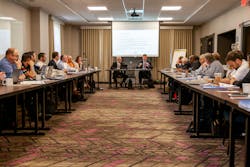Aviation Education Demands Better, Presents Regulatory Solution to Modernize Maintenance Training
While school was out, the Aviation Technician Education Council (ATEC) spent the summer break drafting a proposal that would mandate Federal Aviation Administration (FAA) revision of long-outdated mechanic training mandates. The work paid off. Right before the holiday recess, congressional leaders unveiled a bill that, if passed, would replace aviation maintenance training regulations with the community-drafted language.
The Promoting Aviation Regulations for Technical Training (PARTT) 147 Act (S.3043/H.R.5427) — a bipartisan and bicameral bill championed by Sen. Jim Inhofe (R-OK), Sen. Tommy Duckworth (D-IL), Rep. Don Young (R-AK) and Rep. Cheri Bustos (D-IL) — would direct the FAA to revise the current training mandates in Title 14 Code of Federal Regulations part 147. The regulation and its curriculum directives have not been significantly updated in more than 50 years, resulting in grossly inadequate teaching standards considering the knowledge and skill required for today’s airframe and powerplant (A&P) mechanic. Industry is left holding the bag, forced to retrain new graduates to ensure they can complete basic tasks required to maintain a modern, sophisticated aircraft.
The bill has received broad support from industry. In a joint letter, 20 trade groups including the Aeronautical Repair Station Association, the Aerospace Industries Association, the Aircraft Electronics Association, Airlines for America, the Experimental Aircraft Association, the General Aviation Manufacturers Association, the International Air Transport Association and the National Business Aviation Association, voiced their frustration with continued regulatory inaction and encouraged passage of the legislation.
“Seeing no regulatory relief in sight, the undersigned organizations acknowledge that this legislative “fix” is intended to further escalate the issue after decades of pushing for a new rule to modernize aviation maintenance technician training,” said the group in its letter to congressional leaders. The coalition went on to say that the bill would “ensure a performance-based approach to regulatory oversight and provide flexibility for part 147 schools to develop pipeline programs with high schools and employers.”
Since it was introduced, the PARTT 147 Act has picked up four more co-sponsors, including Sen. Shelley Moore Capito (R-WV), Sen. Richard Burr (R-NC), Sen. Jerry Moran (R-KS) and Rep. Tom Cole (R-OK). The bill is expected to garner additional support as industry grassroots efforts pick up steam.
According to the latest ATEC member survey, enrollments for aviation maintenance programs are decreasing, despite the uptick in starting pay for newly-minted mechanics. While program awareness, instructor salary and access to tools and equipment are leading challenges for maintenance programs looking to fill open classroom seats, schools continue to cite outdated curriculum requirements as a top inhibitor for program growth. Administrators say revamped content will better attract would-be mechanics with an aptitude for hands-on careers in a rapidly evolving field.
While schools have and do provide training above and beyond what is required by the FAA, the part 147, 1,900 hour seat-time mandates limits how much “extra” content a school can incorporate and remain marketable. For Associate’s degree programs, common educational standards set the minimum number of clock hours at 1,800. An A&P program, which oftentimes “compete” with other, more efficient occupational pathway programs, will find it difficult to justify adding more coursework to an already credit-heavy program. Indeed, a school accreditor may not support an associate’s program with excessive credit hour requirements.
A revision to part 147 has been in the FAA rulemaking pipeline for a decade. While relatively recent regulatory proposals (the FAA published a notice of proposed rulemaking in 2015, followed by a supplemental proposal in 2019) would remove static curriculum requirements altogether and provide more flexibility for schools, industry representatives are concerned that the agency’s continued insistence on governing educational aspects in the new rule will further dampen an already stagnant pipeline.
Under the current rule, FAA inspectors dictate grading scales, absentee policies and class sizes; elements already overseen by Department of Education-approved accreditors. New regulatory proposals “double down” on those duplicative requirements and would require even more agency approvals for programs looking to expand their programs to local secondary schools.
The community-draft regulation pursues a different, performance-based approach. It relies heavily on a massive effort to improve A&P mechanic certification testing. The mechanic Airman Certification Standards (ACS) have been in work for nearly four years, and once published, will replace current practical test standards (PTS), and clearly define minimum knowledge and skill requirements for A&P mechanics. The ACS will be regularly reviewed and updated by an FAA-industry committee, and provide the framework for the written, oral and practical mechanic tests, and guidance material.
If passed, the law would utilize the ACS as the basis for curriculum development, which would ensure that testing and training are always correlated and in line with industry needs. (The FAA’s proposed rule takes a different position, creating an entirely separate training standard and review board, something industry vehemently opposes.)
Accredited institutions would rely on the quality systems approved under the Department of Department regulations, without having to go through duplicative FAA endorsements that exist under today’s regulations and in the agency’s proposed revisions. The FAA would be responsible for ensuring schools maintain proper and relevant materials and equipment, that their instructors are qualified and that training aligns with mechanic certification standards. Schools would be responsible for ensuring their programs produce a high passage rate for the aviation mechanic test, which the agency would use as a quality check.
ATEC is calling on industry to reach out to congressional leaders to support the bill. Its legislative toolkit provides congressional letter templates and talking points to educate legislators and encourage them to sign on as a co-sponsor of the PARTT 147 Act, which necessitates committee approval before it goes to the House and Senate floors for a vote.
In the meantime, industry will continue to work with the FAA through the current rulemaking process, with hopes that it will produce a new part 147 by 2022 should the congressional effort fail.
The topic will be high on the list of issues discussed at the ATEC Annual Conference, taking place March 29-April 1 in Fort Worth. All parties interested in getting involved in the effort are invited to attend.





